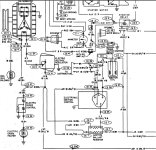Dr.Jass
Pastor of Muppets
Run a 50/50 distilled-water/"mean green" coolant mix, period. Straight water in an engine with mixed metals (iron and aluminum) is a recipe for disaster. It'll cool just fine, but you'll have an ongoing chemical reaction between dissimilar materials with straight water acting as a catalyst that will corrode the aluminum parts badly, eventually destroying them. This is damage I saw firsthand a lot living in the South, but the best example I had was an Edelbrock Performer I bought on eBay from a Florida Man and have mentioned several times previously. The water crossover area was heavily cratered, with some pits 3/4"-1" across and 1/4" deep or more. The thermostat flange was paper thin from the bottom. I'd bought it to resell but couldn't because of the damage. I put it on my Fifth Avenue after thoroughly cleaning and bead-blasting it, and ran a coolant/water mix as required. After a couple of years, the t-stat flange finally let go and the thermostat fell into the water crossover. A cheap used intake is one thing; your heads are quite another.I poured a gallon of distilled water in it tonight. Unsure if the half-and-half water/antifreeze will cool better than just straight water, or vice-versa. Opinions welcome.
Distilled water is a must. Chemicals and minerals in tap water exacerbate corrosion. Ask an auto manufacturer--or just look in an owner's manual (any owner's manual). If distilled water is too much hassle--apparently not in your case--buy the 50/50 pre-mix. Distilled water is used in every version I sell of the stuff: Green, Dexcool, "universal", G05, etc. I generally buy it the majority of the time since overcoming the foolish "paying for water" hang-up. With the time/money spent getting distilled water, the "additional" cost of paying for water is a non-entity.
The only time I'll use straight water is at the track, where they usually demand it. If I went to look at a car with aluminum heads that had straight water in the block, I'd probably pass outright. I'd at least get it to a price where I'm comfortable with replacing the top end.
In my estimation, which is based on several tests I've read, high-falutin' plug wires are one of the greatest loads of hooey foisted upon hot rodders. Chris Jacobs, I believe, did a test decades ago (before he started selling plug wires, of course) in which he found essentially no benefit to big-boy/solid/low-resistance wires. Per the test, the first thing people don't realize is that the greatest resistance in the system isn't the wires, it's the plug gap. Air is an excellent insulator, as is gasoline. Another factor is that just like lightning, spark voltage is very-high-frequency AC and therefore much less affected by resistance over the length of the wire than DC would be. Additionally, there's virtually no amperage there, which is why you don't die when a plug wire zaps you. When you need to push nearly no current, resistance is of very little consequence.I don't remember how much the wires cost but they came from RockAuto and IIRC they were cheap (definitely cheaper than hot rod wires). They're 7mm but how much does that really matter? Maybe small blocks are different than big blocks, but there was no messing around because of too long wires like you have with a B/RB engine.
About the highest-peformance plug wires I'll buy are MSD's Street Fire wires. I like them because of their temperature resistance, low-key appearance and, on the ones I use, multi-angle (bendable) plug-wire ends. I've also used Accel 300+ in the past for similar reasons, plus the fact that yellow writing on a black wire looks stock-ish. I had those on the Black Bitch, and when I melted through one--it fell onto the header--I eventually swapped out to Standard Motor Products' best "stock replacement" wires. I saw no change in performance, nor did Stretch and his racing partner, who got tired of buying high-dollar plug wires for the race car every year. They started using SMP wires--not on my recommendation--just by coincidence and largely for the warranty. After the season, they'd warranty 'em to have fresh wires next season.
The only wires I'll condemn as absolute junk are any Accel offerings below the expensive "300+" level. Their Super Stock wires are complete garbage and have been for decades. The first run-in I had with 'em was in 1987 or '88, when my friend did a complete tune-up on his '71 Impala converted to HEI. He called me because it ran like crap and he wanted outside eyes on it. After screwing around with everything--checking plugs and wire connections, trying various timing points, etc.--I had him shut off the yard lights and start the car. The engine bay looked like Tesla's lab. We pulled off the brandy-new Accel wires, which were yellow to match the car, and reinstalled the battered old set. Problem solved. No more Tampa lightning show and it drove well. The next day he returned the Accel's and bought stock-replacement wires (Filko, as I recall). We both learned a valuable lesson and both later diagnosed/repaired other people's cars by simply saying "Get rid of those f__kin' Accel wires." I cannot recall any successful installations of those wires, nor can I think of any other problematic wire brand other than Belkin (NAPA). We sell inexpensive Federal and Parts Master (made by SMP but not their premium stuff) wires at the store, with 90% being the Federals. Other than a few fitment issues I've never heard a complaint.
Speaking of fitment issues, the Mopar Performance "restoration" small-block wires don't fit worth a damn.
I'm sure whatever you bought are probably fine.

